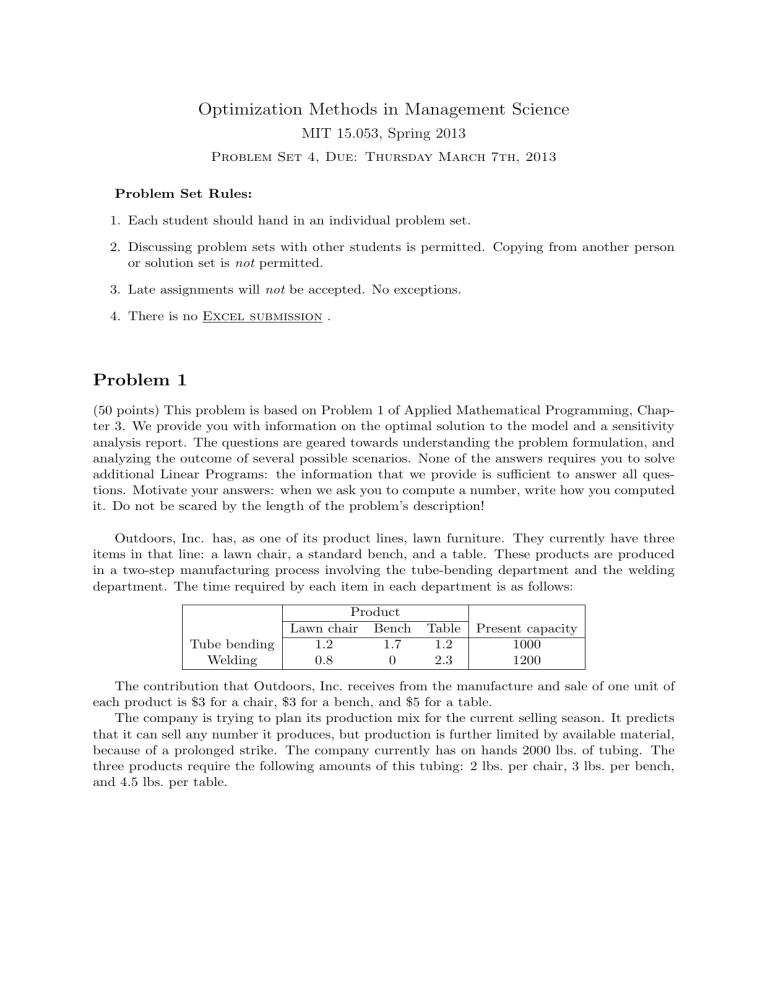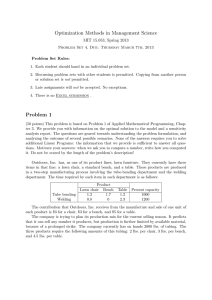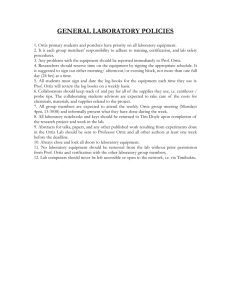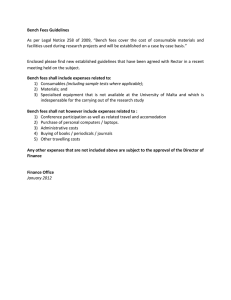Document 13447025

Optimization Methods in Management Science
MIT 15.053, Spring 2013
Problem Set 4, Due: Thursday March 7th, 2013
Problem Set Rules:
1.
Each student should hand in an individual problem set.
2.
Discussing problem sets with other students is permitted.
Copying from another person or solution set is not permitted.
3.
Late assignments will not be accepted.
No exceptions.
4.
There is no
Excel submission
.
Problem 1
(50 points) This problem is based on Problem 1 of Applied Mathematical Programming, Chap ter 3.
We provide you with information on the optimal solution to the model and a sensitivity analysis report.
The questions are geared towards understanding the problem formulation, and analyzing the outcome of several possible scenarios.
None of the answers requires you to solve additional Linear Programs: the information that we provide is sufficient to answer all ques tions.
Motivate your answers: when we ask you to compute a number, write how you computed it.
Do not be scared by the length of the problem’s description!
Outdoors, Inc.
has, as one of its product lines, lawn furniture.
They currently have three items in that line: a lawn chair, a standard bench, and a table.
These products are produced in a two-step manufacturing process involving the tube-bending department and the welding department.
The time required by each item in each department is as follows:
Tube bending
Welding
Product
Lawn chair Bench Table
1.2
0.8
1.7
0
1.2
2.3
Present capacity
1000
1200
The contribution that Outdoors, Inc.
receives from the manufacture and sale of one unit of each product is $3 for a chair, $3 for a bench, and $5 for a table.
The company is trying to plan its production mix for the current selling season.
It predicts that it can sell any number it produces, but production is further limited by available material, because of a prolonged strike.
The company currently has on hands 2000 lbs.
of tubing.
The three products require the following amounts of this tubing: 2 lbs.
per chair, 3 lbs.
per bench, and 4.5
lbs.
per table.
In order to determine the optimal product mix, the production manager has formulated the following linear program:
Label
Bending
Welding
Material Availability
Contribution
Chair Bench Table
1.2
0.8
1.7
0
Limit
1.2
≤ 1000
2.3
≤ 1200
2
3
3
3
4.5
≤ 2000
5
Solving this linear program with Excel and asking for a sensitivity report on the solution yields the information reported in Figure 1.
Objective Cell (Max)
Cell Name
$B$4 Contribution
Original Value Final Value
0 2766.666667
Variable Cells
Cell
$B$1 Chair
$B$2 Bench
$B$3 Table
Name Original Value Final Value Integer
0 700 Contin
0 0 Contin
0 133.3333333 Contin
Constraints
Cell Name
$B$5 Bending
$B$6 Welding
$B$7 Material Availability
Variable Cells
Cell
$B$1 Chair
$B$2 Bench
$B$3 Table
Name
Constraints
Cell Name
$B$5 Bending
$B$6 Welding
$B$7 Material Availability
Cell Value Formula Status Slack
1000 $B$5<=1000 Binding 0
866.6666667 $B$6<=1200 Not Binding 333.3333333
2000 $B$7<=2000 Binding 0
Final
Value
Reduced
Cost
700 0
0 -1.38333333
133.3333333
0
Objective
Coefficient
Allowable Allowable
Increase Decrease
3 2 0.777778
3 1.383333333
5 1.75
1E+30
2
Final
Value
Shadow
Price
1000 1.166666667
866.6666667
2000
0
0.8
Constraint Allowable Allowable
R.H. Side Increase Decrease
1000 200 466.6667
1200 1E+30 333.3333
2000 555.5555556 333.3333
Figure 1: Solution information and sensitivity analysis for Problem 1.
Note that “contin” in the second table means continuous and can be ignored
2
Use solution and sensitivity report to answer the following questions.
(a) (5 points) What is the optimal production mix?
What contribution can the firm anticipate by producing this mix?
(b) (5 points) What is the value of one more unit of tube-bending time?
of welding time?
of metal tubing?
Guess the value of one more unit of welding time just by looking at the third table in Figure 1, under the column “Slack”.
(c) (6 points) A local distributor has offered to sell Outdoors, Inc.
some additional metal tubing for $0.70/lb.
Should Outdoors buy it?
If yes, how much would the firm’s contribution increase if they bought 550 lbs.
and used it in an optimal fashion?
(d) (6 points) If Outdoors, Inc.
feels that it must produce at least 50 benches to round out its product line, what effect will that have on its contribution?
(Hint: First answer the question for one bench and then extend it for 50 benches).
(e) (7 points) The R&D department has been redesigning the bench to make it more profitable.
The new design will require 1.2
hours of tube-bending time, 3.0
hours of welding time, and
2.4
lbs.
of metal tubing.
If it can sell one unit of this bench with a unit contribution of
$2.5, what would be overall contribution if they produce a single unit?
(f) (7 points) Marketing has suggested a new patio awning that would require 1.8
hours of tubebending time, 0.5
hours of welding time, and 1.3
lbs.
of metal tubing.
What contribution must this new product have to make it attractive to produce this season?
(g) (7 points) Outdoors, Inc.
has a chance to sell some of its capacity in tube bending at cost of $1 .
50/hour.
If it sells 200 hours at that price, how will this affect contribution?
(h) (7 points) If the contribution on chairs were to decrease to $2.40, what would be the optimal production mix and what contribution would this production plan give?
(24 points, 4 points each) A wood furniture manufacturing firm asked your help in analyzing their production schedule.
The firm can produce four types of furniture: Chairs, Desks, Tables,
Wardrobes.
Each item requires a certain number of man-hours in three departments: Cutting,
Sanding, Finishing.
On the next page, a solution report is given in Figure 2, where Revenue is expressed in dollars.
A sensitivity report is given in Figure 3.
Using these two exhibits, answer the following questions.
Note that three values, identified by “A”, “B” and “C”, are missing from Figure 3.
Two of the questions will ask you to compute “A” and “B”.
The missing values are not needed for the remaining questions.
(a) By how much should the revenue for selling one unit of Chairs increase, before Chairs could be considered for production in the optimal production mix?
(b) The firm is considering the possibility of buying equipment to increase the current Sanding capacity.
What is the maximum amount that the firm should be willing to pay to increase the number of available Sanding hours from 800 to 850?
(c) Suppose the profit of Tables decreased from 100 to 95.
What would be the new optimal solution?
What would be the new profit?
(If there is not enough information in the problem to give the answer, please state so.)
3
Objective Cell (Max)
Cell Name
$C$11 Revenue
Variable Cells
Cell
$C$2
$D$2
$E$2
$F$2
Name
Chairs
Desks
Tables
Wardrobes
Constraints
Cell
$C$15
$C$16
$C$17
Name
Cutting
Sanding
Finishing
Original Value
0
Original Value
0
0
0
0
Cell Value
480
800
800
Final Value
18000
Final Value
0
0
140
25
Status
Binding
Binding
Not Binding
Figure 2: Solution report for Problem 1.
Slack
0
0
100
Variable Cells
Cell
$C$2
$D$2
$E$2
$F$2
Constraints
Name
Chairs
Desks
Tables
Wardrobes
Cell
$C$15
$C$16
$C$17
Name
Cutting
Sanding
Finishing
Final Reduced Objective Allowable Allowable
Value Cost Coefficient Increase Decrease
0
0
140
25
-130
A
0
0
40
90
100
160
B
C
100
240
1E+30
1E+30
10
80
Final Shadow Constraint Allowable Allowable
Value Price R.H. Side Increase Decrease
480
800
800
12.5
15
0
480
800
900
1120
100
1E+30
160
560
100
Figure 3: Sensitivity report for Problem 2.
(d) To cut costs, the firm wants to reduce the number of hours in the Finishing department from 900 to 700.
Which of the following statements is the most accurate?
• Reducing the number of Finishing hours by 200 will not affect total revenue.
• Reducing the number of Finishing hours by 200 will decrease revenue by $100.
• Reducing the number of Finishing hours by 200 could affect total revenue, but we do not have enough information to compute the magnitude of the change.
(e) The contribution of each unit of Desks to Revenue is 90.
Producing one unit of Desks requires 2 hours of Cutting, 5 hours of Sanding, and 7 hours of Finishing.
Compute the missing value “A” in Figure 3, that is, the reduced costs of Desks.
Show your work.
(f) Compute the missing value “B” in Figure 3, that is, the allowable increase in the row labeled
“Chairs”.
Problem 3
(26 points) The Red Sox are playing the Yankees.
It’s the bottom of the 9th inning, with two outs and bases loaded.
The score is tied 3 to 3.
Mariano Rivera is pitching for the Yankees.
David Ortiz is batting for the Red Sox.
What pitch should Rivera throw?
How should David
Ortiz bat?
In this simplified version of the problem, Rivera can throw one of three pitches: a high inside fastball, a high outside fastball, or a high inside curve.
Ortiz can prepare for the pitch by expecting a curveball or a fastball.
The probability of Ortiz scoring a run is given in
Table 1.
If he doesn’t score a run, then he is out, and the inning ends.
Prepare for Curveball
Prepare for Fastball
High Inside fastball
0.3
0.5
High Outside fastball
0.3
0.2
High Inside
Curve
0.4
0.3
Table 1: The probability of Ortiz scoring a run under different scenarios.
Assume in the following that Ortiz and Rivera both take a conservative strategy with regards to their mixed strategies.
(That is, take the conservative analysis developed in class wrt mixed strategies.)
(a) (7 points) Formulate Ortiz’s problem (the row player’s problem) as a linear program.
(b) (7 points) Formulate Mariano Rivera’s problem (the column player’s problem) as a linear program.
(c) (8 points) Solve Ortiz’s problem using a graphical approach.
What is the optimum mixed strategy?
What is the probability of Ortiz scoring a run if he uses the optimal mixed strategy.
(d) (4 points) Without solving Rivera’s problem, what is the probability that Ortiz is out if
Rivera uses his best mixed strategy.
(Choose the largest value that is correct.) Briefly justify your answer.
5
MIT OpenCourseWare http://ocw.mit.edu
1 5 .053 Optimization Methods in Management Science
Spring 201 3
For information about citing these materials or our Terms of Use, visit: http://ocw.mit.edu/terms .




